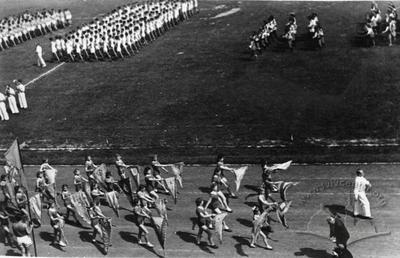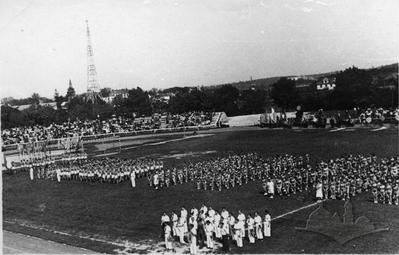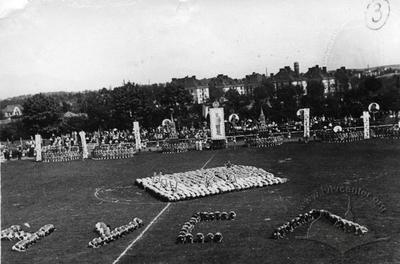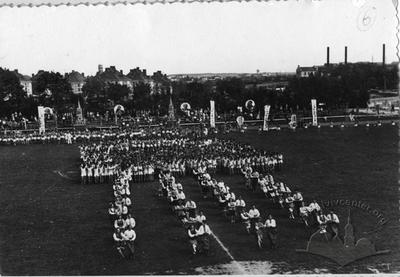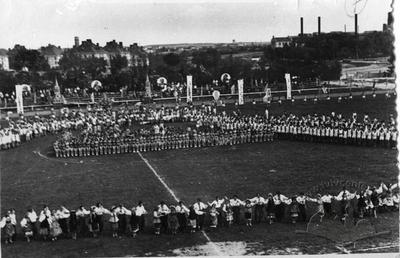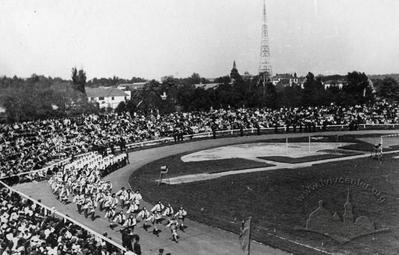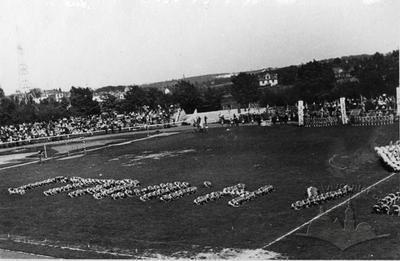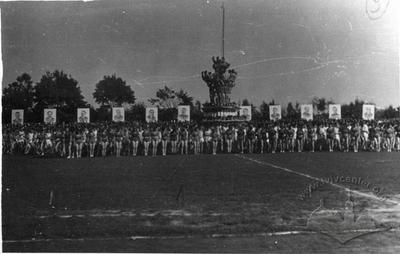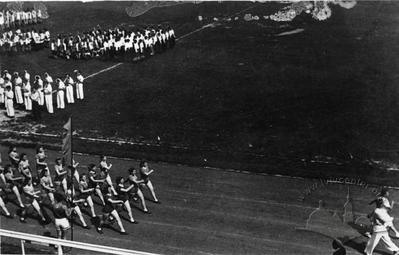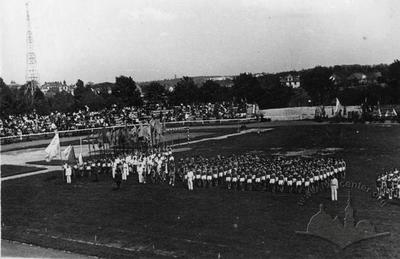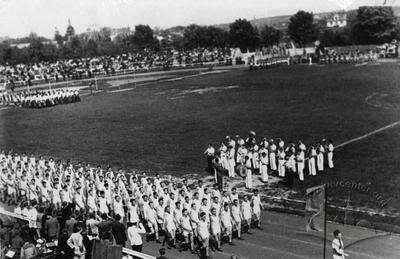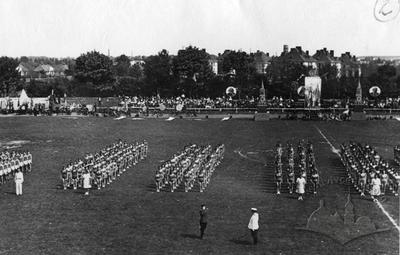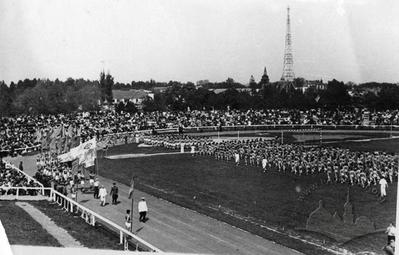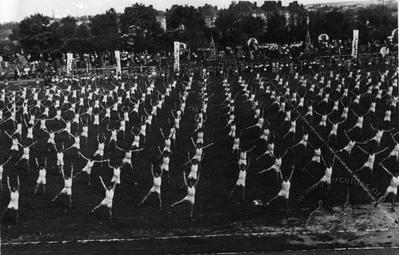Vul. Stryiska, 35 – former "Czarni" sports complex ID: 2183
The complex was built in 1923, according to the design by an engineer Ludwik Christelbauer. It was owned by the First Lviv Sporting Club "Czarni". It included football grounds (the main and the training ground), track courses, the stand (a concrete, and a wooden one), a cycling track, tennis courts, basketball and volleyball ground, and the training halls in the basement storey of the main stand. From 1939 until the early 1980s, it was managed by the sports society "Dynamo." In 1986–1996, on the site of the complex, buildings of the State Taxation Service of Ukraine, the Ivan Krypyakevych Institute of Ukrainian Studies of the NAS of Ukraine were constructed. Currently, there is also a campus of the Ukrainian Catholic University.
Story
In the end of 1903, the pupils of the 1st Real School in Lviv, as guided by the fifth-grader Kazimierz Soltyński, established a football group "Sława" (The Glory) (Z przeszłosci, 1921, 2). The name did not last long, though. Due to the colous of their outfits, black and red, in 1905–1906, the group assumed the name "Czarni" (The Black). Thus, they preceded the official registration of the club which statute was adopted on July, 9, 1908 (CDIAL 146/25/1597:1–3). The document records it as "The First Club of Foot Ball in Lviv" (Pierwszy klub Pilki Noznej we Lwowie). The group grew dynamically. On November, 22, 1919, the delegates of the Special General Meeting of the Club renamed it into the "1st Lviv Sporting Club "Czarni"(Piłka, 1996, 67). It implies they also pursued other kinds of sports, in addition to football.Since they did not have their own sporting facility, the club used the ground of the facilities of the Society of Sporting Games built near Vulky toll house (presently, it is the upper part of Sakharova street). It was only in 1921 that the "Czarni" received their own land plot on Stryiska street, with the cycling ground and the city hippodrome (Lwów і Wilno, 1997, 62). According to the design by Ludwik Chrishtelbauer, they started building here a sporting facility to be completed in 1924, even though the stadium was opened on June, 29, 1923 (Krzysztofowicz, 1993, 4).
On September, 2, 1923, they held the first in Lviv international game on the level of national teams, Poland – Romania (scoring 1:1) (Bryl,1982, 189, 192). A forward player of the "Czarni" Juliusz Miller took part (Lwów i Wilno, 1997, 63–64). The arena of the "Czarni" had hosted the games of national teams two more times: in 1926, of Poland — Turkey (6:1); and in 1934, of Poland — Romania (3:3) (Bryl, 1982, 232; Lwów i Wilno, 1997, 64).
"Czarni" were co-founders of the Polish Football League in 1927 playing with the strongest Polish teams of the time for 7 years (1927–1933) (Piłka, 1996, 64). The leaders of the team in the period were Rochus Nastulia, Jan Drapała, Anton Wronka, Aleksandr Krasicki, Jan Reyman, and Stefan Witkowski.
Overnight into September, 3, 1930, the facility gravely suffered from the fire (Lwów i Wilno, 1997, 70). The fire destroyed the stands, service premises, and sports equipment (Hatys, 1977, 466). The losses were estimated to amount to 60 000 zloty. Immediately after this case, they started collecting donations to reconstruct the facility. It was completed in August 1931. On August, 2, 1931, the arena was put to order and was named "Sports Park named after Marshall Pilsudski." The football ground hosted two Lviv teams — the "Czarni" and "Lechia" (Raz, Dwa, 1931, 3).
On November, 1, 1931, the sporting association was named the "1st Military-Civilian Sports Club the "Czarni" (Księga, 1939, 63). In those times, the strongest part of the club was not about the football players but about ice-skaters Tadeusz Kowalski and Zofia Bilor, the best in Europe in sports ice dancing.
The last head of the club before the war in 1939 was a colonel Ludwik Bittner (Piłka, 1996, 68). When in December 1939 a Soviet Sports Society "Dynamo" was established, the facilities of the "Czarni" was passed on to "Dynamo"’s disposal (Кордіяк, 1980, 24). In 1940, the society conducted the reconstruction of the facility. The works were managed by Tadeusz Kuchar, one of the famous athlete brothers (Bryl, 1982, 301). Some improvements were also introduced later. In particular, the facilities received another football pitch, a training wall for the firefighting sports. In summertime, they also installed a boxing ring, while in wintertime they arranged a skating rink. The "Dynamo" society was maintaining the facility until the 1980s, when it was liquidated and the construction of a large administrative public center started (Лемко, 2009, 292; Мельник, 2008, 349; Трегубова, 1989, 214). However, they only partially implemented the projects.
The "Dynamo" facility had a huge significance for the sports life of Lviv. It hosted traditional festivities on the Day of Physical Culturist, the Spartakiad Games, the games of tennis, football, the tournaments in boxing, hockey, and archery. The football pitch gave rise to the Lviv team of "Karpaty." They first went out to play in March 1963 (Кордіяк, 1980, 24; Лемко 2009, 292). In 1976, the "Dynamo" facility was the home arena for the 14th Spartakiad Games of Schoolchildren, for the International Rugby Tournament that was little spread in the USSR in those times. The international tennis tournament on the local courts became famous. During the games, the viewers could enjoy the skillful play of Lviv Dynamo members Serhiy Hruzman, Oleksandr Zaluzhnyi, and Larysa Savchenko. The cyclists Yaroslav Svirskyi and Yuriy Zayats manifested great success, too.
Architecture
The complex of buildings of Lviv Sports Society "Czarni" was located on Stryiska road, behind the toll house on the premises of the Cetner cycling ground and the hippodrome of the Society for Horse Breeding (Towarzystwo hodowli koni). On the northern side, it bordered with the territory of East Fair (upper part of Stryiskiy park) and the stadium of the "Sokil-Batko" society. Westwards, on the opposite side of Stryiska street, there was a sports complex of Lviv Sports Society "Pogoń."It was built in 1923–1924 and consisted of the cycling ground that used to be there before, of two football grounds (the main one, with the stands, track racecourses and jumping places, and the smaller one, the training ground, located on the side of Stryiska street). There were two roofed stands, one opposite another — the main western stand made of reinforced concrete, and the eastern wooden stand. After the fire of 1930, the arena was modernized and expanded. The main stand was renovated most. The armored concrete structure could shelter 1800 persons. The basement storey had gym halls, changing rooms and service premises. No other stand in the contemporary Poland could compare to it (Raz, Dwa, 1931, 3). A real pride of the club was the grass surface of the main football ground. It was perfectly smooth, thick-set, and mowed twice a day. It had no analogues in those times in Poland (Lwów i Wilno, 1997, 75). The stadium could seat 10–12 thousand of viewers. The time was taken by the clocks of the "Etera" company, later — by "Oteda." The northern part of the facility had base coated courts, volleyball and basketball grounds. Next to the training ground, there was a small public garden that led to the main stand.
When the facility used to belong to the "Dynamo" society, it had also undergone certain changes. Right behind the wooden stand, they fitted another training ground and increased the number of courts to 8. In wintertime, they served as a hockey rink. In the northern part of the stadium, a building for the hotel and administrative premises were built. On the east side, next to the training ground, a wooden three-storey wall for firefighters' competitions was constructed. The stadium was oval shaped. The entire area of the facility was surrounded with the stone fence, and had another entrance on the side of vul. I. Franka.
The complex had existed in such condition until the early 1980s. At the time, they were guided by the idea of polymetric system of urban transport and demolished the facilities. On the site, a construction of an administrative public center was started but not finished. Only the Ivan Krypyakevych Institute of Ukrainian Studies was finished on the third reserve ground, and a high-rise building of the State Taxation Service (on the site of the main football ground, the training ground, the public square and the main monolithic stand). In place of the courts and a volleyball and basketball ground, the campus of Ukrainian Catholic University is under construction. The only remaining facility is the building of the former hotel that now places a banking institution, and a fragment of the eastern part of the facility, on the side of Kozelnytska street.
People
Zofia Bilor, Tadeusz Kowalski— figure skaters, champions of Poland in sports ice dancing, bronze medal winners of the 1934 European Championship in Prague.Maksymilian Wudkewicz — a trackman, the strongest speed walking athlete of the Austrian period.
Serhiy Hruzman — a tennis player, winner of many international tournaments.
Yuriy Zayats — a cyclist, winner of the World Bicycle Race 1977.
Ludwik Christelbauer — a construction engineer, a designer of the sports facility "Czarni" on vul. Stryiska, head of the Football Union of Galicia in 1913.
Marian Bilor — a football player, the most prominent member of the club team before the First World War.
Juliusz Miller — a football player, the first representative of the club in the national team of Poland; he played 6 games in the team in 1922–1926.
Nastula Rochus — a football player, hit the largest number of goals in the club.
Yaroslaw Swirski — a lead cyclist of the "Dynamo" in the 1940s.
Kazimierz Soltyński — a founder of the "First Lviv Football Club "Sława" (1 Lwowski Klub Pilki Noznej "Slawa"), later — of the "Czarni", the first head of the club in 1903.
Leonard Stahl — initiated the construction of the sports facility of the "Czarni" in 1923.
Sources
- Central State Historical Archives of Ukraine in Lviv (CDIAL) 146/25/1597:153
- Кордіяк Юліан, Чемпіони живуть у Львові: Нариси, статті (Львів:Каменяр, 1980), 176.
- Лемко Ілько, Михалик Володимир, Бегляров Георгій, 1243 вулиці Львова (Львів: Апріорі, 2009), 574.
- Мельник, Ігор, Львівські вулиці і кам’яниці, мури, закамарки, передмістя та інші особливості королівського столичного міста Галичини (Львів: Центр Європи, 2008), 384.
- Трегубова Тетяна, Мих Роман, Львів. Архітектурно-історичний нарис (Київ: Будівельник, 1989), 270.
- Bryl Jacek, Waclaw Kuchar (Warszawa: Krajowa Agencja Wydawnicza, 1982), 350.
- "Z przeszłosci sportu futbalowego i lekkoatletycznego w okręgu Lwowskim", Ilustrowany tygodnik sportowy, 1921, Nr. 6, 14 sierpnia, 2.
- Hatys Józef, Polska piłka nozna (Kraków, 1977), 446.
- Krzysztofowicz Jerzy, "Lwowski Klub Sportowy "Czarni" (1903–1939), Trener, 1993, Nr. 1, 4.
- Księga pamiątkowa poświęcona 35-leciu działalności Lwowskiego Klubu Sportowego "Pogoń" 1904–1939 (Lwów, 1939), 422.
- Lwów i Wilno w ekstraklasie. Dzieje polskiego futbolu kresowego (Katowice: GA, 1997), 192.
- Piłka nozna na ziemi Lwowskiej 1894–1939 (Warszawa: SPAR, 1996), 158.
- Raz, Dwa, Trzy, 1931, 4 września, 3.
Urban Media Archive Materials
